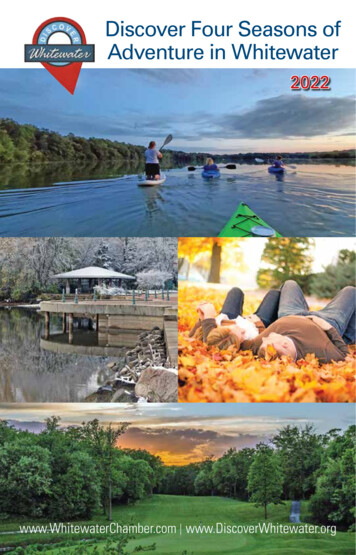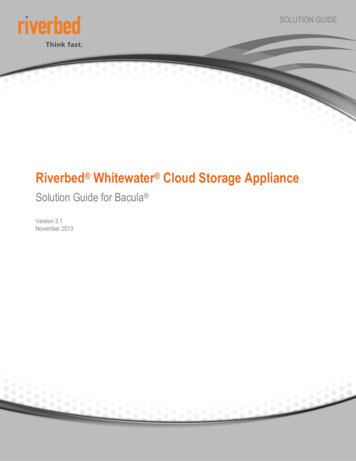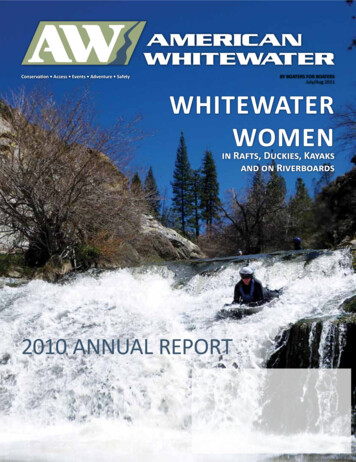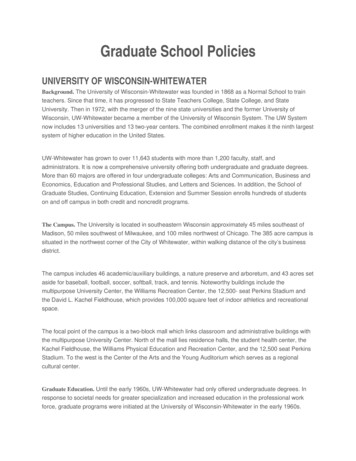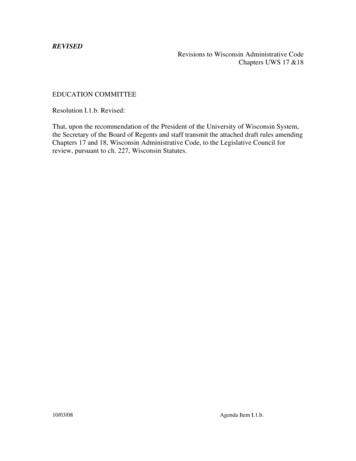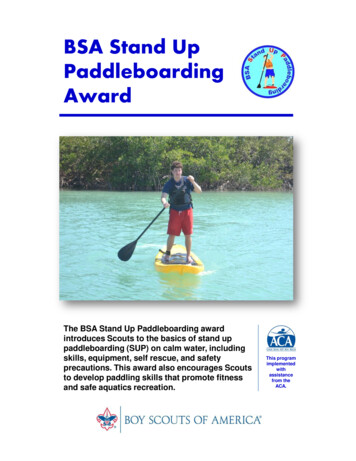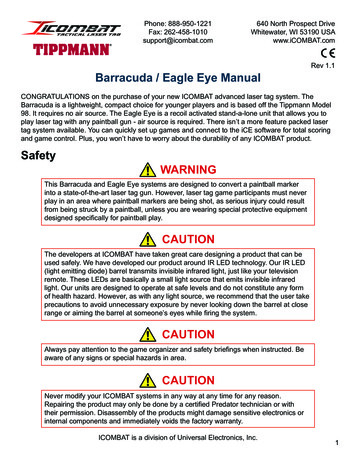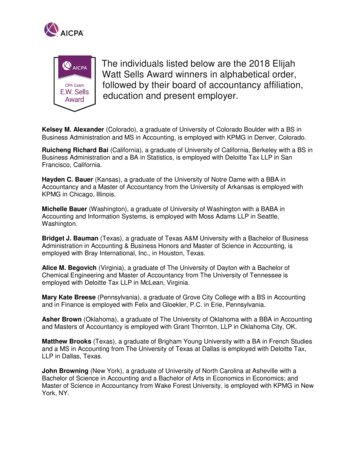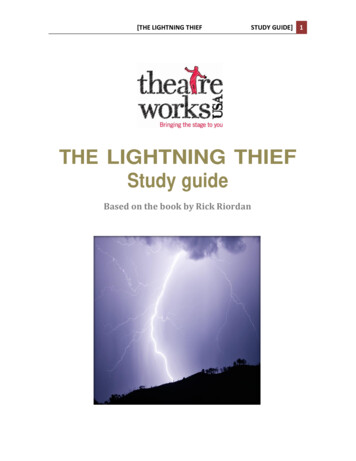
Transcription
WhitewaterMerit Badge WorkbookThis workbook can help you but you still need to read the merit badge pamphlet.This Workbook can help you organize your thoughts as you prepare to meet with your merit badge counselor.You still must satisfy your counselor that you can demonstrate each skill and have learned the information.You should use the work space provided for each requirement to keep track of which requirements have been completed,and to make notes for discussing the item with your counselor, not for providing full and complete answers.If a requirement says that you must take an action using words such as "discuss", "show","tell", "explain", "demonstrate", "identify", etc, that is what you must do.Merit Badge Counselors may not require the use of this or any similar workbooks.No one may add or subtract from the official requirements found in Scouts BSA Requirements (Pub. 33216 – SKU 653801).The requirements were last issued or revised in 2020 This workbook was updated in June 2020.Scout’s Name:Unit:Counselor’s Name: Phone No.: Email:http://www.USScouts.Org http://www.MeritBadge.OrgPlease submit errors, omissions, comments or suggestions about this workbook to: Workbooks@USScouts.OrgComments or suggestions for changes to the requirements for the merit badge should be sent to: Merit.Badge@Scouting.Org1. Do the following:a Explain to your counselor the most likely hazards you may encounter while participating in whitewater activities,including branches and trees in water along a shore and stretching across the stream, rocks, hydraulics overledges or lowhead dams, strong wind, low water or air temperature, and thunder and lightning storms. Explainwhat you should do to anticipate, help prevent, mitigate, and respond to these hazards.Workbook Copyright 2020 - U.S. Scouting Service Project, Inc. - All Rights ReservedRequirements Copyright, Boy Scouts of America (Used with permission.)This workbook may be reproduced and used locally by Scouts and Scouters for purposes consistent with the programs of theBoy Scouts of America (BSA), the World Organization of the Scout Movement (WOSM) or other Scouting and Guiding Organizations.However it may NOT be used or reproduced for electronic redistribution or for commercial or other non-Scoutingpurposes without the express permission of the U. S. Scouting Service Project, Inc. (USSSP).
WhitewaterScout's Name:b Review with your counselor the prevention, symptoms, and first aid treatment for the following injuries orillnesses that could occur while participating in whitewater activities including cold-water shock; hypothermia;head, neck, and back injuries; heat-related illnesses; sunburn; dehydration; blisters; bruises; cuts; sprains andstrains; shoulder dislocation; and submersion injuries.Cold-water shock:Hypothermia:Head injuries:Neck injuries:Back Whitewater - Merit Badge WorkbookPage. 2 of 16
WhitewaterScout's Name:Blisters:BruisesCutsSprainsStrains:Shoulder dislocation:Submersion injuries:c. Discuss with your counselor the BSA Safety Afloat policy and the American Whitewater safety guidelines,including the use of helmet and life jackets.Whitewater - Merit Badge WorkbookPage. 3 of 16
WhitewaterScout's Name:2. Do the following:a. Demonstrate understanding of the following river features by drawing lines to show the flow of water: upstreamV, downstream V, eddy with an eddy line, ledge, river bend, current at different depths, drop, horizon line, andhydraulic.Upstream VDownstream VEddy with an eddyline:LedgeRiver bendCurrent at differentdepthsDropHorizon lineWhitewater - Merit Badge WorkbookPage. 4 of 16
WhitewaterScout's Name:Hydraulic:b. Describe how waves form including standing waves and wave trains.c. Explain how to tilt or edge the boat without leaning your body1. When entering and exiting an eddy.2. When ferrying in downstream and upstream directions.d. Explain when, why, and how you should scout a river while ashore and while on the river and when you shouldportage your boat.Whitewater - Merit Badge WorkbookPage. 5 of 16
WhitewaterScout's Name: 3. Before doing requirements 4 through 12, earn the Canoeing merit badge if you will be using a canoe to earn this meritbadge. If you will be using a kayak, earn the Kayaking merit badge. Earn the Canoeing merit badge Earn the Kayaking merit badgeThen do the following: a If you will be using a canoe to earn this merit badge, demonstrate strokes and maneuvers from the Canoeingmerit badge to the satisfaction of your merit badge counselor.OR b If you will be using a kayak to earn this merit badge, demonstrate strokes and maneuvers from the Kayakingmerit badge to the satisfaction of your merit badge counselor.4. Do ONE of the following: a. If you are completing these requirements as a tandem canoeist, perform the following on calm water: 1. Demonstrate the following strokes in the bow: cross forward, bow draw, cross bow draw, bow pry, andsculling draw. cross forward bow pry bow draw sculling draw. cross bow draw 2. Demonstrate the following strokes in the stern: stern draw, stern pry, sculling draw, and forward withstern pry. stern draw sculling draw stern pry forward with stern pry 3. Demonstrate a high brace, low brace, and righting pry. high brace low brace righting pryOR b If you are completing these requirements as a solo canoeist, perform the following on calm water: 1. Demonstrate the following strokes: cross forward, bow draw, cross bow draw, stern draw, pry, sternpry, sculling draw, and forward with stern pry. cross forward pry bow draw stern pry cross bow draw sculling draw stern draw forward with stern pry 2. Demonstrate a high brace, low brace, and a righting pry. high brace low brace righting pryOR c If you are completing these requirements as a solo kayaker, perform the following on calm water: 1. Demonstrate the following strokes: bow draw, rudder, and sculling draw. bow draw rudder sculling draw 2. Demonstrate a high brace and low brace. high brace low braceWhitewater - Merit Badge WorkbookPage. 6 of 16
WhitewaterScout's Name:5. Do the following:a. Explain the International Scale of River Difficulty and apply the scale to the stretch of river approved by yourcounselor.b. Identify the specific characteristics of the river that are factors in your classification according to theInternational Scale.c. Discuss how the level of flow changes a river from one class to another and what effects different flow rateshave on the features of a river and its hazards.Whitewater - Merit Badge WorkbookPage. 7 of 16
WhitewaterScout's Name:6. Explain the importance of communication during every whitewater outing.Demonstrate knowledge and ability to use the following American Whitewater Universal River Signals, both visual andauditory: “Stop,” “Are you OK?,” “Help/emergency,” “Run river right,” “Run river left,” and “All clear—come ahead.”. “Stop,” “Run river right,” “Are you OK?,” “Run river left,” “Help/emergency,” All clear—come ahead.”7. Do ONE of the following: a. If completing this merit badge in a canoe, describe the various types of canoes used on moving water and howthey differ in design, materials, and purpose.OR b. If completing this merit badge in a kayak, describe the various types of kayaks used on moving water andexplain how they differ in design, materials, and purpose.Whitewater - Merit Badge WorkbookPage. 8 of 16
WhitewaterScout's Name:8. Discuss the personal and group equipment necessary for a safe whitewater outing and how and why it is used.PersonalGroupExplain how to pack and protect these items. 9. Demonstrate your ability to read a Class II section of river approved by your counselor. Describe the most desirablepaths or lines of travel as well as alternative routes and optionsWhitewater - Merit Badge WorkbookPage. 9 of 16
WhitewaterScout's Name:Point out how to use the existing water features to your advantage, and explain how to best avoid the hazards present.10. Wearing a proper life jacket and being appropriately dressed for the weather and water conditions, perform the followingskills in moving water in a properly equipped whitewater craft of your choice (tandem canoe, solo canoe, or solo kayak).If a tandem canoe is used, the skills must be demonstrated from both the bow and stern positions. 1. Launch and land. 2. Paddle forward in a straight line at least 10 boat lengths. 3. Backpaddle in a straight line at least five boat lengths. 4. Ferry upstream from both sides of the river. 5. Ferry downstream from both sides of the river. 6. Eddy turn from both sides of an eddy. 7. Peel out from both sides of an eddy.11. Explain and demonstrate the following to your counselor:a. Self-rescue and procedures when capsized in moving water, including a wet exit if necessaryb. Proper use of a throw rope to rescue a swimmer in whitewaterWhitewater - Merit Badge WorkbookPage. 10 of 16
WhitewaterScout's Name:c. Proper technique for receiving a throw rope as a swimmerd. Portaging—where portaging would be appropriate, and when and how to do itf. The whitewater buddy system using at least three persons and three craft. 12. Participate in one or more whitewater trips using either a canoe or kayak on a Class I and/or Class II river. The trip(s)must involve at least six hours of paddling time. For each trip:a. Help to prepare a written plan, specifying the route (put-ins and takeouts), schedule, equipment, safetyprecautions, and emergency procedures.Route:Schedule:Whitewater - Merit Badge WorkbookPage. 11 of 16
WhitewaterScout's es: b. Determine local rules and obtain permission from landowners and land managers in advance.c. Explain what steps you have taken to comply with BSA Safety Afloat and the American Whitewater safetyguidelines. d Show how to protect personal and group equipment from water and how to load and secure the containers inboats to be used in the trip. Execute the plans with other paddlers.e. Explain to your counselor how well your plans worked for each trip taken.When working on merit badges, Scouts and Scouters should be aware of some vital information in the current edition ofthe Guide to Advancement (BSA publication 33088). Important excerpts from that publication can be downloaded meritbadges.pdf.You can download a complete copy of the Guide to Advancement from itewater - Merit Badge WorkbookPage. 12 of 16
SAFETY AFLOATBSA groups shall use Safety Afloat for all boating activities. Adultleaders supervising activities afloat must have completed SafetyAfloat training within the previous two years. Cub Scout activitiesafloat are limited to council or district events that do not includemoving water or float trips (expeditions). Safety Afloat standardsapply to the use of canoes, kayaks, rowboats, rafts, floating tubes,sailboats, motorboats (including waterskiing), and other smallcraft, but do not apply to transportation on large commercialvessels such as ferries and cruise ships. Parasailing (being towedairborne behind a boat using a parachute), kitesurfing (using awakeboard towed by a kite), and recreational use of personalwatercraft (small sit-on-top motorboats propelled by water jets) arenot authorized BSA activities.3.Jump feetfirst into water over the head in depth. Level offand swim 75 yards in a strong manner using one or more ofthe following strokes: sidestroke, breaststroke, trudgen, orcrawl; then swim 25 yards using an easy, resting backstroke.The 100 yards must be completed in one swim without stopsand must include at least one sharp turn. After completingthe swim, rest by floating.2.For activity afloat, those not classified as a swimmer arelimited to multiperson craft during outings or float trips oncalm water with little likelihood of capsizing or fallingoverboard. They may operate a fixed-seat rowboat or pedalboat accompanied by a buddy who is a swimmer. They mayride in a canoe or other paddle craft with an adult swimmerskilled in that craft as a buddy. They may ride as part of agroup on a motorboat or sailboat operated by a skilled adult.Qualified SupervisionAll activity afloat must be supervised by a mature andconscientious adult age 21 or older who understands andknowingly accepts responsibility for the wellbeing and safetyof those in his or her care and who is trained in andcommitted to compliance with the nine points of BSA SafetyAfloat. That supervisor must be skilled in the safe operationof the craft for the specific activity, knowledgeable in accidentprevention, and prepared for emergency situations. If theadult with Safety Afloat training lacks the necessary boatoperating and safety skills, then he or she may serve as thesupervisor only if assisted by other adults, camp staffpersonnel, or professional tour guides who have theappropriate skills. Additional leadership is provided in ratiosof one trained adult, staff member, or guide per 10participants. For Cub Scouts, the leadership ratio is onetrained adult, staff member, or guide per five participants. Atleast one leader must be trained in first aid including CPR.Any swimming done in conjunction with the activity afloatmust be supervised in accordance with BSA Safe SwimDefense standards. It is strongly recommended that all unitshave at least one adult or older youth member currentlytrained in BSA Aquatics Supervision: Paddle Craft Safety toassist in the planning and conduct of all activities afloat.Personal Health ReviewA complete health history is required of all participants asevidence of fitness for boating activities. Forms for minorsmust be signed by a parent or legal guardian. Participantsshould be asked to relate any recent incidents of illness orinjury just prior to the activity. Supervision and protectionshould be adjusted to anticipate any potential risksassociated with individual health conditions. For significanthealth conditions, the adult supervisor should require anexamination by a physician and consult with parent,guardian, or caregiver for appropriate precautions.Whitewater - Merit Badge WorkbookSwimming AbilityOperation of any boat on a float trip is limited to youth andadults who have completed the BSA swimmer classificationtest. Swimmers must complete the following test, whichshould be administered annually.Safety Afloat training may be obtained from the BSA OnlineLearning Center at www.scouting.org, at council summer camps,and at other council and district training events. Confirmation oftraining is required on local and national tour permits for trips thatinvolve boating. Additional guidance on appropriate skill levelsand training resources is provided in the Aquatics Supervisionguide available from council service centers.1.Page 1 of 24.Life JacketsProperly fitted U.S. Coast Guard–approved life jackets mustbe worn by all persons engaged in boating activity (rowing,canoeing, sailing, boardsailing, motorboating, waterskiing,rafting, tubing, and kayaking). Type III life jackets arerecommended for general recreational use.For vessels over 20 feet in length, life jackets need not beworn when participants are below deck or on deck when thequalified supervisor aboard the vessel determines that it isprudent to abide by less-restrictive state and federalregulations concerning the use and storage of life jackets, forexample, when a cruising vessel with safety rails is atanchor. All participants not classified as swimmers mustwear a life jacket when on deck underway.Life jackets need not be worn when an activity falls underSafe Swim Defense guidelines—for example, when aninflated raft is used in a pool or when snorkeling from ananchored craft.5.Buddy SystemAll participants in an activity afloat are paired as buddies whoare always aware of each other’s situation and prepared tosound an alarm and lend assistance immediately whenneeded. When several craft are used on a float trip, eachboat on the water should have a “buddy boat.” All buddypairs must be accounted for at regular intervals during theactivity and checked off the water by the qualified supervisorat the conclusion of the activity. Buddies either ride in thesame boat or stay near each other in single-person craft.Page. 13 of 16
SAFETY AFLOAT6.Skill Proficiencyequipment, food, and shuttle services. Lists of group and personalequipment and supplies must be compiled and checked. Evenshort trips require selecting a route, checking water levels, anddetermining alternative pull-out locations. Changes in water level,especially on moving water, may pose significant, variable safetyconcerns. Obtain current charts and information about thewaterway and consult those who have traveled the route recently.Everyone in an activity afloat must have sufficient knowledge andskill to participate safely. Passengers should know how theirmovement affects boat stability and have a basic understanding ofself-rescue. Boat operators must meet government requirements,be able to maintain control of their craft, know how changes in theenvironment influence that control, and undertake activities only thatare within their personal and group capabilities.Float Plan. Complete the preparation by writing a detailed itinerary,or float plan, noting put-in and pullout locations and waypoints,along with the approximate time the group should arrive at each.Travel time should be estimated generously. Notification. File thefloat plan with parents, the local council office if traveling on runningwater, and local authorities if appropriate. Assign a member of theunit committee to alert authorities if prearranged check-ins areoverdue. Make sure everyone is promptly notified when the trip isconcluded.Content of training exercises should be appropriate for the age,size, and experience of the participants, and should cover basicskills on calm water of limited extent before proceeding to advancedskills involving current, waves, high winds, or extended distance. Ata minimum, instructors for canoes and kayaks should be able todemonstrate the handling and rescue skills required for BSAAquatics Supervision: Paddle Craft Safety. All instructors musthave a least one assistant who can recognize and respondappropriately if the instructor’s safety is compromised.Weather. Check the weather forecast just before setting out, andkeep an alert weather eye. Anticipate changes and bring all craftashore when rough weather threatens. Wait at least 30 minutesbefore resuming activities after the last incidence of thunder orlightning.Anyone engaged in recreational boating using human powered crafton flatwater ponds or controlled lake areas free of conflictingactivities should be instructed in basic safety procedures prior tolaunch, and allowed to proceed after they have demonstrated theability to control the boat adequately to return to shore at will.Contingencies. Planning must identify possible emergencies andother circumstances that could force a change of plans. Developalternative plans for each situation. Identify local emergencyresources such as EMS systems, sheriff’s departments, or rangerstations. Check your primary communication system, and identifybackups, such as the nearest residence to a campsite. Cell phonesand radios may lose coverage, run out of power, or suffer waterdamage.For recreational sailing, at least one person aboard should be ableto demonstrate basic sailing proficiency (tacking, reaching, andrunning) sufficient to return the boat to the launch point. Extendedcruising on a large sailboat requires either a professional captain oran adult with sufficient experience to qualify as a bareboat skipper.Motorboats may be operated by youth, subject to staterequirements, only when accompanied in the boat by anexperienced leader or camp staff member who meets staterequirements for motorboat operation. Extended cruising on a largepower boat requires either a professional captain or an adult withsimilar qualifications.8.Unit trips on whitewater above Class II must be done with either aprofessional guide in each craft or after all participants havereceived American Canoe Association or equivalent training for theclass of water and type of craft involved.9.PlanningProper planning is necessary to ensure a safe, enjoyable exerciseafloat. All plans should include a scheduled itinerary, notification ofappropriate parties, communication arrangements, contingencies incase of foul weather or equipment failure, and emergency responseoptions.Preparation. Any boating activity requires access to the properequipment and transportation of gear and participants to the site.Determine what state and local regulations are applicable. Getpermission to use or cross private property. Determine whetherpersonal resources will be used or whether outfitters will supplyEquipmentAll craft must be suitable for the activity, be seaworthy, and float ifcapsized. All craft and equipment must meet regulatory standards,be properly sized, and be in good repair. Spares, repair materials,and emergency gear must be carried as appropriate. Life jacketsand paddles must be sized to the participants. Properly designedand fitted helmets must be worn when running rapids rated aboveClass II. Emergency equipment such as throw bags, signal devices,flashlights, heat sources, first-aid kits, radios, and maps must beready for use. Spare equipment, repair materials, extra food andwater, and dry clothes should be appropriate for the activity. Allgear should be stowed to prevent loss and water damage. For floattrips with multiple craft, the number of craft should be sufficient tocarry the party if a boat is disabled, and critical supplies should bedivided among the craft.Before a unit using human-powered craft controlled by youthembarks on a float trip or excursion that covers an extendeddistance or lasts longer than four hours, each participant shouldreceive either a minimum of three hours training and supervisedpractice, or demonstrate proficiency in maneuvering the crafteffectively over a 100-yard course and recovering from a capsize.7.Page 2 of 2DisciplineRules are effective only when followed. All participants shouldknow, understand, and respect the rules and procedures for safeboating activities provided by Safety Afloat guidelines. Applicablerules should be discussed prior to the outing and reviewed for allparticipants near the boarding area just before the activity afloatbegins. People are more likely to follow directions when they knowthe reasons for rules and procedures. Consistent, impartiallyapplied rules supported by skill and good judgment providestepping-stones to a safe, enjoyable outing.For additional information on Safety Afloat, go to float.aspx.Whitewater - Merit Badge WorkbookPage. 14 of 16
SAFE SWIM DEFENSEBSA groups shall use Safe Swim Defense for all swimmingactivities. Adult leaders supervising a swimming activity must havecompleted Safe Swim Defense training within the previous twoyears. Safe Swim Defense standards apply at backyard, hotel,apartment, and public pools; at established waterfront swim areassuch as beaches at state parks and U.S. Army Corps of Engineerslakes; and at all temporary swimming areas such as a lake, river,or ocean. Safe Swim Defense does not apply to boating or wateractivities such as waterskiing or swamped boat drills that arecovered by Safety Afloat guidelines. Safe Swim Defense appliesto other nonswimming activities whenever participants enter waterover knee deep or when submersion is likely, for example, whenfording a stream, seining for bait, or constructing a bridge as apioneering project. Snorkeling in open water requires eachparticipant to have demonstrated knowledge and skills equivalentto those for Snorkeling BSA in addition to following Safe SwimDefense. Scuba activities must be conducted in accordance withthe BSA Scuba policy found in the Guide to Safe Scouting.Because of concerns with hyperventilation, competitiveunderwater swimming events are not permitted in Scouting.Safe Swim Defense training may be obtained from the BSA OnlineLearning Center at olc.scouting.org, at council summer camps,and at other council and district training events. Confirmation oftraining is required on local and national tour permits for trips thatinvolve swimming. Additional information on various swimmingvenues is provided in the Aquatics Supervision guide availablefrom council service centers.1.2.3.Qualified SupervisionAll swimming activity must be supervised by a mature andconscientious adult age 21 or older who understands andknowingly accepts responsibility for the well-being and safetyof those in his or her care, and who is trained in andcommitted to compliance with the eight points of BSA SafeSwim Defense. It is strongly recommended that all units haveat least one adult or older youth member currently trained inBSA Aquatics Supervision: Swimming and Water Rescue orBSA Lifeguard to assist in planning and conducting allswimming activities.Personal Health ReviewA complete health history is required of all participants asevidence of fitness for swimming activities. Forms for minorsmust be signed by a parent or legal guardian. Participantsshould be asked to relate any recent incidents of illness orinjury just prior to the activity. Supervision and protectionshould be adjusted to anticipate any potential risksassociated with individual health conditions. For significanthealth conditions, the adult supervisor should require anexamination by a physician and consult with the parent,guardian, or caregiver for appropriate precautions.Safe AreaAll swimming areas must be carefully inspected andprepared for safety prior to each activity. Water depth,quality, temperature, movement, and clarity are importantconsiderations. Hazards must be eliminated or isolated byconspicuous markings and discussed with participants.Page 1 of 2Controlled Access: There must be safe areas for allparticipating ability groups to enter and leave the water.Swimming areas of appropriate depth must be defined foreach ability group. The entire area must be within easy reachof designated rescue personnel. The area must be clear ofboat traffic, surfing, or other nonswimming activities.Bottom Conditions and Depth: The bottom must be clearof trees and debris. Abrupt changes in depth are not allowedin the nonswimmer area. Isolated underwater hazards shouldbe marked with floats. Rescue personnel must be able toeasily reach the bottom. Maximum recommended waterdepth in clear water is 12 feet. Maximum water depth inturbid water is 8 feet.Visibility: Underwater swimming and diving are prohibited inturbid water. Turbid water exists when a swimmer treadingwater cannot see his feet. Swimming at night is allowed onlyin areas with water clarity and lighting sufficient for goodvisibility both above and below the surface.Diving and Elevated Entry: Diving is permitted only intoclear, unobstructed water from heights no greater than 40inches. Water depth must be at least 7 feet. Bottom depthcontours below diving boards and elevated surfaces requiregreater water depths and must conform to state regulations.Persons should not jump into water from heights greater thanthey are tall, and should jump only into water chest deep orgreater with minimal risk from contact with the bottom. Noelevated entry is permitted where the person must clear anyobstacle, including land.Water Temperature: Comfortable water temperature forswimming is near 80 degrees. Activity in water at 70 degreesor less should be of limited duration and closely monitored fornegative effects of chilling.Water Quality: Bodies of stagnant, foul water, areas withsignificant algae or foam, or areas polluted by livestock orwaterfowl should be avoided. Comply with any signs postedby local health authorities. Swimming is not allowed inswimming pools with green, murky, or cloudy water.Moving Water: Participants should be able to easily regainand maintain their footing in currents or waves. Areas withlarge waves, swiftly flowing currents, or moderate currentsthat flow toward the open sea or into areas of danger shouldbe avoided.Weather: Participants should be moved from the water to aposition of safety whenever lightning or thunder threatens.Wait at least 30 minutes after the last lightning flash orthunder before leaving shelter. Take precautions to preventsunburn, dehydration, and hypothermia.Life Jacket Use: Swimming in clear water over 12 feet deep,in turbid water over 8 feet deep, or in flowing water may beallowed if all participants wear properly fitted, Coast Guard–approved life jackets and the supervisor determines thatswimming with life jackets is safe under the circumstances.
SAFE SWIM DEFENSE4.5.6.Response Personnel (Lifeguards)Every swimming activity must be closely and continuouslymonitored by a trained rescue team on the alert for and readyto respond during emergencies. Professionally trainedlifeguards satisfy this need when provided by a regulatedfacility or tour operator. When lifeguards are not provided byothers, the adult supervisor must assign at least two rescuepersonnel, with additional numbers to maintain a ratio of onerescuer to every 10 participants. The supervisor must provideinstruction and rescue equipment and assign areas ofresponsibility as outlined in Aquatics Supervision, No. 34346.The qualified supervisor, the designated response personnel,and the lookout work together as a safety team. Anemergency action plan should be formulated and shared withparticipants as appropriate.Anyone who has not completed either the beginner orswimmer tests is classified as a nonswimmer.The nonswimmer area should be no more than waist to chestdeep and should be enclosed by physical boundaries suchas the shore, a pier, o
Whitewater - Merit Badge Workbook Page. 6 of 16 3. Before doing requirements 4 through 12, earn the Canoeing merit badge if you will be using a canoe to earn this merit badge. If you will be using a kayak, earn the Kayaking merit badge. Earn the Canoeing merit badge Earn the Kayaking merit badge Then do the following:
